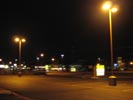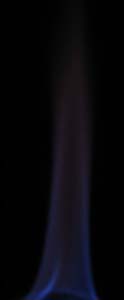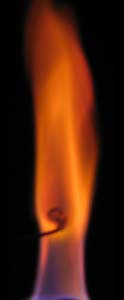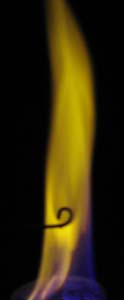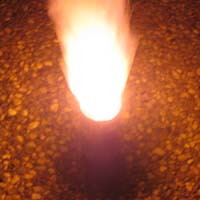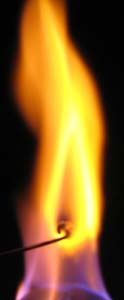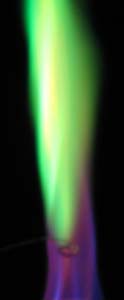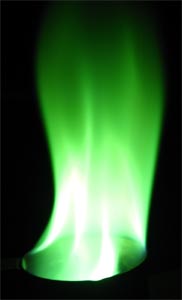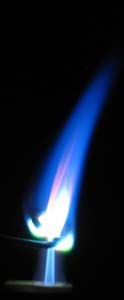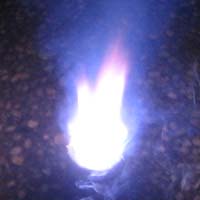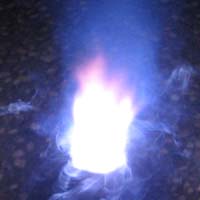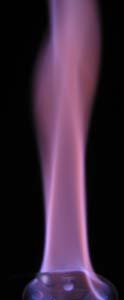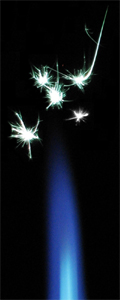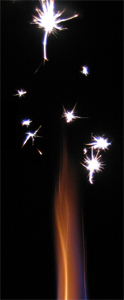Flame Test
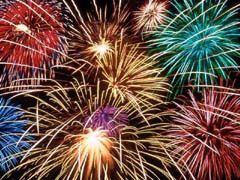 A flame test is a
procedure used to test qualitatively for the presence of
certain metals in chemical compounds. When the
compound to be studied is excited by heating it in a flame,
the metal ions will emit light. Based on the
emission spectrum of the element, the compound will change
the color of the flame to a characteristic color. This
technique of using certain chemical compounds to color
flames is widely used in pyrotechnics to produce the range
of colors seen in firework displays.
A flame test is a
procedure used to test qualitatively for the presence of
certain metals in chemical compounds. When the
compound to be studied is excited by heating it in a flame,
the metal ions will emit light. Based on the
emission spectrum of the element, the compound will change
the color of the flame to a characteristic color. This
technique of using certain chemical compounds to color
flames is widely used in pyrotechnics to produce the range
of colors seen in firework displays.
To perform a flame test,
prepare a solution of the compound to be tested by
dissolving it in deionized
water. Next, clean an inert wire loop
by immersing it in a dilute hydrochloric acid solution, then
rinsing with deionized water. Repeat this process
until no distinct color is seen after placing the loop into
a flame. When the wire loop is clean, dip it into the
solution to be tested and place the loop into the hottest
part of a non-luminous flame. Observe and record the
color of the flame.
 A
porous wooden splint may be substituted for the metal
loop. Pre soak the wood splint in deionized water to
wash out any ionic impurities, then soak the splint in the
solution to be tested. Place the end of the wood
splint into the flame and observe any color changes, but be
careful not to leave the splint in too long, causing it to
catch fire and burn with a luminous flame, masking the color
imparted by the metal ions present.
A
porous wooden splint may be substituted for the metal
loop. Pre soak the wood splint in deionized water to
wash out any ionic impurities, then soak the splint in the
solution to be tested. Place the end of the wood
splint into the flame and observe any color changes, but be
careful not to leave the splint in too long, causing it to
catch fire and burn with a luminous flame, masking the color
imparted by the metal ions present.
|
Certain metal ions will
turn the flame distinctive colors; these colors intern can
help identify the presence of the particular metal present
the compound. However, some colors are produced by
several different metals, making it hard to determine the
exact ion or concentration of the ion in the compound.
Some colors are very weak and are easily overpowered by
stronger colors. For instance, the presence of a
potassium ions (K+) in a compound will color a
flame violet / lilac, on the other hand, even trace amounts
of sodium ions (Na+) in a compound produce a very
strong yellow flame, often times making the potassium ion
very difficult to detect. To counteract the effects of
any sodium impurities, one can view the flame through a
piece of cobalt blue
glass ![]() . The cobalt glass
absorbs the yellow light given off by sodium ions while
letting most other wavelengths of light pass through.
More recently, didymium
glass has been substituted for cobalt glass due to its
superior ability to block undesirable light.
. The cobalt glass
absorbs the yellow light given off by sodium ions while
letting most other wavelengths of light pass through.
More recently, didymium
glass has been substituted for cobalt glass due to its
superior ability to block undesirable light.
Coloring Fire
Below is a table listing chemical compounds used to obtain a desired color in a flame.
| Color | Element [common compounds] |
| Red [Pictures] | lithium [Li2CO3], strontium [SrCO3, Sr(NO3)2] |
| Orange [Pictures] | calcium [CaCO3, CaSO4] |
| Yellow [Pictures] | sodium [NaCl, NaNO3, Na2CO3] |
| Yellowish-Green | boron [Borax - Na2B4O7] |
| Green [Pictures] | barium [Ba(NO3)2, BaCl2], copper [CuSO4] |
| Blue [Pictures] | copper [CuO, CuCO3], copper halides [e.g., CuCl2] |
| Purple-Violet [Pictures] | potassium [KClO3, KCl, KNO3, K2SO4] |
| White-Silver [Pictures] | aluminum, magnesium, titanium |
Plain
Above: An almost colorless ethanol flame, without any chemical colorants
Red
Left: Lithium chloride and lithium
carbonate color an ethanol flame red.
Right: Strontium chloride and strontium carbonate
color an ethanol flame red-orange.
Orange
Left: Calcium
chloride is used to color an ethanol flame orange.
Right (2 pictures): A mixture of potassium
chlorate and sugar burns with the coloring agent calcium
carbonate (CaCO3) giving it an orange color.
Yellow / Yellowish-Green
Left: Sodium chloride imparts a bright,
strong, yellow color to an ethanol flame.
Right: Borax (sodium tetraborate) colors the ethanol
flame a light yellow-green.
Green
Left: Copper(II) chloride colors a cool
ethanol flame a vivid green.
Right: Trimethyl borate burns with a
vivid
green flame without the need for the addition of a colorant.
When boric acid is mixed with methanol, trimethyl borate, a
volatile (high vapor pressure) and flammable substance, is
formed. Trimethyl borate will burn with a green flame without
the need to add additional colorants.
Blue
Left:
A hot, butane flame is colored a bright blue by copper(II)
chloride.
Right (2 pictures): A mixture of
potassium chlorate and sugar burns with a bright blue color
due to the copper(II) sulfate (CuSO4) coloring
agent.
Purple-Violet
Above:An ethanol flame is colored purple / lilac by potassium chloride.
White-Silver
Above: Small magnesium metal turnings burn above a butane flame (left) and ethanol flame (right).
| Description |
Video
|
|---|---|
| A piece of Titanium metal gives off bright sparks as it is pressed against a fast-spinning sanding pad. |
Additional Pictures
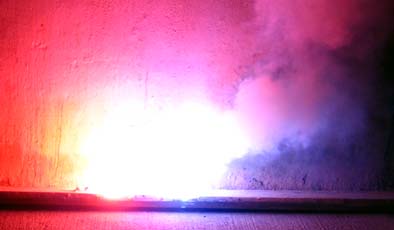
Above: Potassium chlorate and sugar react along with
various
flame coloring agents to produce flames of every color in the
spectrum.
copper(II) chloride, lithium carbonate, and calcium carbonate.
Last updated:
09/25/2017



